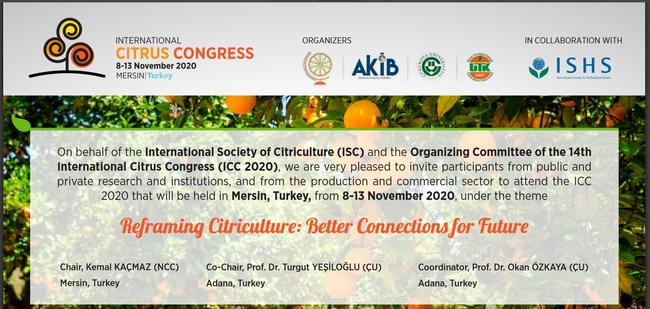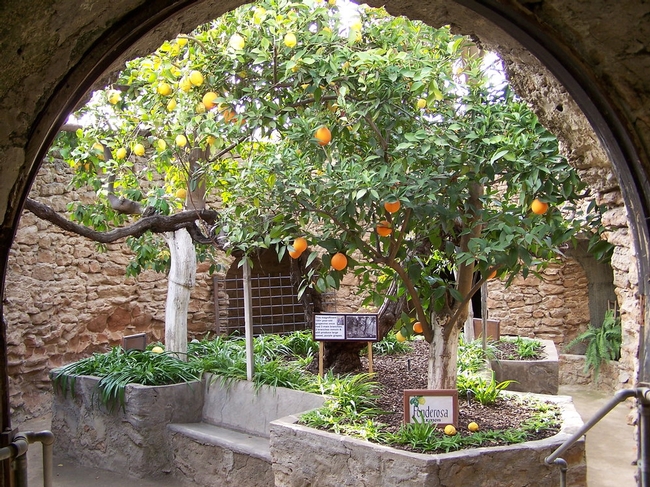On behalf of the International Society of Citriculture (ISC) and the Organizing Committee of the 14th International Citrus Congress (ICC 2020), we are very pleased to invite participants from public and private research and institutions, and from the production and commercial sector to attend the ICC 2020 that will be held in Mersin, Turkey, from 8-13 November 2020, under the theme “Reframing Citriculture: Better Connections for Future”. The Congress is being organized by the Mediterranean Exporters' Association (MEA), Çukurova University (ÇU) and National Citrus Council (NCC). These three institutions will cooperate with universities, research institutes, associations, companies, growers, exporters and sponsors. The Congress that will be realized with attendance of all stakeholders concerning whole citrus industry attracts attention with all activities including a number of workshop, plenary, oral presentation and poster sessions which cover policies, comments, approaches under the theme “Reframing Citriculture: Better Connections for Future”. So citrus will be reframe for better connection in future
Historians believe that the ancestor of the citrus trees, Citrus medica L., was introduced from India into Anatolia (Turkey) in the late 4th century BC. Today, Turkey is the 8th largest citrus producer in the World. Total citrus production of Turkey was 4.902.052 t. Oranges are the main citrus fruit grown in Turkey, accounting for about 43% of total production (1.900.000 t). Orange production is followed by mandarins (1.650.000 t), lemons (1.100.000 t), grapefruit (250.000 t) and others (2.052 t). Citrus area has expanded rapidly and reached 135.643 ha. This expansion is driven by domestic and export demands. It is believed that Turkey has a production potential at least three times of the present level. (TUIK, 2018)
The major citrus producing areas are located along Turkey's southern Mediterranean (88%) and Aegean coastal plains (12%), where typical mild or cool Mediterranean subtropical climate prevails. The most producer provinces are Adana (1.142.686 t), Mersin (1.052.992 t) and Hatay (906.392 t) in the Eastern Mediterranean. The Mediterranean climate is more suitable for high quality citrus; continue to shift to citrus from field crops (cotton and grains) because of its more attractive returns. In these regions, high quality citrus fruit production is oriented particularly towards fresh fruit markets and consumption.
Most of Turkey's citrus production is used for the local fresh fruit market and for export. Turkey has a significant place in international citrus trade, particularly in fresh citrus fruit exports. In the total global fresh citrus fruit export, Turkey was the second in the world. In recent years, exports of citrus, especially mandarin, have steadily increased.
The first settlement in Mersin, the host city of ICC 2020, which is known as Cilicia in ancient times, dates as far back as to the New Stone Age. It is one of the important ports of the Mediterranean and the center of maritime commerce just as it was during ancient times. As a settlement of dominant powers since Neolithic Period, Mersin hosts many archaeological and historical monuments remaining from Chalcolithic, Hittite, Roman, Byzantine and Ottoman civilizations. Therefore, many important figures in the history of civilization, such as Alexander the Great, Saint Paul, Cleopatra, Aya Thecla, Prophet Daniel, lived in this area and changed the course of history.
During the congress, a great many scientific activities such as plenary and ordinary sessions, workshops and poster display to establish new links and collaborations among participants will be carried out by well-appointed scientists who will come from all of the world. Furthermore, participants will find opportunities to see both Turkish citrus industries and historical background by technic and social pre, mid and post Congress tours.
We look forward to meeting you in Turkey.
Website: https://www.icc2020.org/
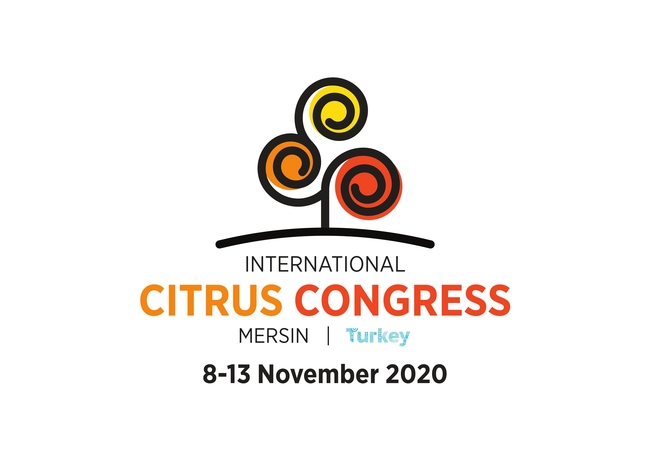
ICC logo
Posted on
Monday, October 21, 2019 at
6:41 AM
The Soil Science Society of America had its North American Societies Conference (Canada/Mexico/US combined societies) in San Diego this month - https://www.sacmeetings.org/
1,700 people came and gave talks. Lots of talks!!! You can review the topics covered by various categories, such as mineralogy, soil chemistry, microbiology, fire impacts on soil, climate change, soil physics, irrigation management, etc, etc, etc -
https://scisoc.confex.com/scisoc/2019sssa/meetingapp.cgi/ModuleProgramBook/0
or by what was presented each day -
https://scisoc.confex.com/scisoc/2019sssa/meetingapp.cgi/ModuleSessionsByDay/0
It's a huge amount of information. By clicking on the session, its possible to see the different speakers and topics and see an abstract of the talk. For example, clicking on the Monday, 9:30 AM session on Fire in the Landscape:
reveals a bunch of talks
https://scisoc.confex.com/scisoc/2019sssa/meetingapp.cgi/Session/18403
clicking on the 11 AM talk by Jeff Hatten gives:
24-7 Fire Effects on Soil Organic Matter in a Southern Appalachian Hardwood Forest: Connecting the Movement of Fire-Altered Organic Matter in Soil and Aquatic Systems'. Jeff A. Hatten1, Lauren Matosziuk2, Adrian Gallo1, Katherine Heckman3, Kevin D. Bladon4, Lucas E. Nave5, Brian D. Strahm6, Tyler Weiglein7, Jessie Egan8, Maggie Bowman9 and Ryan Stewart10, (1)Department of Forest Engineering, Resources and Management, Oregon State University, Corvallis, OR, (2)Oregon Sate University, Corvallis, OR, (3)Northern Research Station, USDA Forest Service (FS), Houghton, MI, (4)Department of Forest Engineering, Resources, and Management, Oregon State University, Corvallis, OR, (5)University of Michigan Biological Station, Pellston, MI, (6)310C Cheatham Hall (0324), Virginia Tech, Blacksburg, VA, (7)310 West Campus Dr., Virginia Tech, Blacksburg, VA, (8)University of Colorodo Boulder, Boulder, CO, (9)INSTAAR, University of Colorado Boulder, Boulder, CO, (10)Crop and Soil Environmental Sciences, Virginia Tech, Blacksburg, VA
And clicking on the title will give the abstract : 24-7 Fire Effects on Soil Organic Matter in a Southern Appalachian Hardwood Forest: Connecting the Movement of Fire-Altered Organic Matter in Soil and Aquatic Systems'.
Fire can have dramatic effects on the quantity and quality of soil organic matter (SOM). While combustion of the O-horizon causes direct losses of SOM, fire also transforms the remaining SOM into a spectrum of thermally altered organic matter. This spectrum ranges from hydrophilic, low molecular weight compounds to highly condensed, hydrophobic carbon (i.e., black carbon and PAHs). These compounds have differing mobility in the environment, and thus their impacts on soils and aquatic systems vary by their mobility. The objectives of this study are to Examine the fate and mobility of 1) particulate and hydrophobic compounds such as black carbon and PAHs and 2) hydrophilic compounds in soil and aquatic dissolved organic matter. Studying the effects of wildfire is always challenging due to the rapid post-fire changes to the environment and lack of robust controls. We overcame those limitations by examining the Chimney Tops 2 Fire which burned 4,617 ha of the Great Smokey Mountain (GRSM) National Park, a National Ecological Observatory Network (NEON) site, in November 2016. We have examined soils from three-time points from an area burned a low-severity (pre-, immediate post-, and 11 months post-fire) and two-time points from areas burned at low to high severity (immediate post-, and 11 months post-fire). These soil profiles have been examined for black carbon and PAH contents. We are currently collecting information on the mobile phases of soil and aquatic organic matter. Here, we will present preliminary data from a study examining the effects of fire on the movement of thermally altered dissolved carbon in soils. All samples have a high concentration of black carbon, and as a result, we could not detect a change in black carbon as a result of a low-severity fire. All profiles showed that the proportion of carbon as black carbon increased with depth to about 10cm and remained constant, suggesting that black carbon is being turned over at a slower rate than other forms of carbon at depth. Samples collected along a severity gradient showed that severity and time-since fire affected the black carbon content. We have evidence that the majority of black carbon missing from the surface soils (i.e., ash bed) has moved into the top 5cm of mineral soil. We expect that the hydrophobic PAHs will follow a similar pattern as black carbon. Overall, we intend for this information to facilitate a thorough examination of the effect of fire on the relative flux of carbon through soil profiles and into aquatic systems.
So, this is how some organic matter moves through the soil after a fire. It doesn't all go up into the air as carbon dioxide, some of it actually migrates deeper into the soil and will probably persist there for a long long time.
Or maybe the whole issue of what constitutes a Healthy Soil interests you? Check out these talks:
https://scisoc.confex.com/scisoc/2019sssa/meetingapp.cgi/Session/18511
Read more about similar and different presentations at the Conference. The full papers based on the abstracts will be out at some later date once they have been properly reviewed for accuracy. That usually takes several months to get all of these presentations organized.
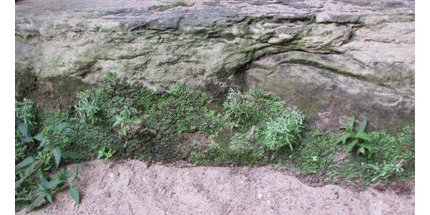
soil weathered from sndstone
Posted on
Friday, January 25, 2019 at
5:10 PM
Please join us for the 7th Annual Citrus Field Day, designed for citrus growers and citrus industry representatives. Pending approval, we will be offering 5.0 hours of California Continuing Education Credit for Pest Control Advisers (PCA).
CLICK HERE TO REGISTER
CLICK HERE TO DOWNLOAD EVENT FLYER
CLICK HERE FOR THE UCR CAMPUS MAP

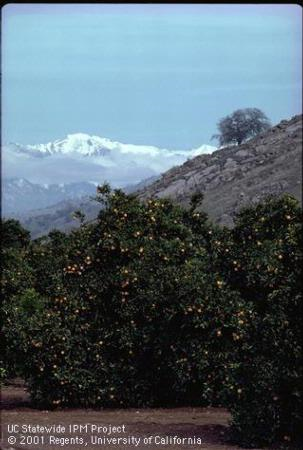
citrus and mountains
Posted on
Wednesday, January 24, 2018 at
2:04 PM
The California Chapter of the American Agronomy Society meets in Fresno this coming February 6-7. This is a multi-day conference with numerous speakers covering all manner of agricultural and environmental issues primarily related to California issues.
Agronomy (Ancient Greek ?γρ?ς agrós 'field' + ν?μος nómos 'law') is the science and technology of producing and using plants for food, fuel, fiber, and land reclamation. Agronomy has come to encompass work in the areas of plant genetics, plant physiology, meteorology, and soil science. It is the application of a combination of sciences like biology, chemistry, economics, ecology, earth science, and genetics. Agronomists of today are involved with many issues, including producing food, creating healthier food, managing the environmental impact of agriculture, and extracting energy from plants.[1] Agronomists often specialise in areas such as crop rotation, irrigation and drainage, plant breeding, plant physiology, soil classification, soil fertility, weed control, and insect and pest control. So there's talk of trees too and plant health and a bit of everything.
And when you are in Fresno you can also swing around to see the underground forest there at Forestiere Gardens.
http://www.undergroundgardens.com/
And also hang around for World Ag Expo in Tulare, February 13-15.
https://www.worldagexpo.com/
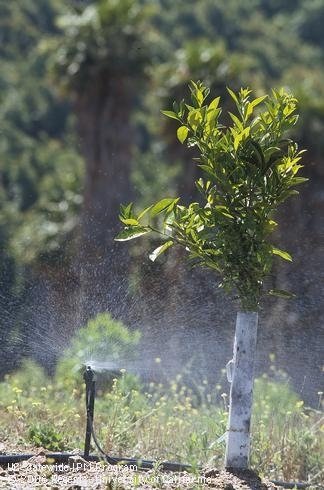
irrigATING CITRUS
Posted on
Wednesday, January 3, 2018 at
2:30 PM
The proceedings of the 5th International Conference on Huanglongbing (IRCHLB V) is now published, available and citable online through the Journal of Citrus Pathology: http://escholarship.org/uc/iocv_journalcitruspathology
Included are:
Meeting Agenda
Published Abstracts
Joseph (Josy) M. Bové - Selected Photos
Joseph (Josy) M. Bové Dedication
Tribute to Prof. Dr. Joseph Bové
If you download the Bové Dedication pdf file, there is a link near the top of page 3 that will redirect you to the video interview of Prof. Bové. This is the video that we could not show during the meeting due to audiovisual technical difficulties. You must download the pdf for the link to be active. The link is not active when simply viewing the publication online.
The keynote speakers are working on their contributions. These will be available shortly and we will send another email announcement when they become available as well.
sIn the bottom left corner is the Search box for finding authors and topics of the abstracts.

ICC picture
Posted on
Wednesday, May 24, 2017 at
5:57 AM
Tags:
acp (145),
asian citrus psyllid (76),
citrus (469),
conference (5),
disease (125),
grapefruit (26),
hlb (133),
huanglongbing (97),
lemon (106),
mandarin (71),
orange (69),
pests (141),
pummelo (3)


